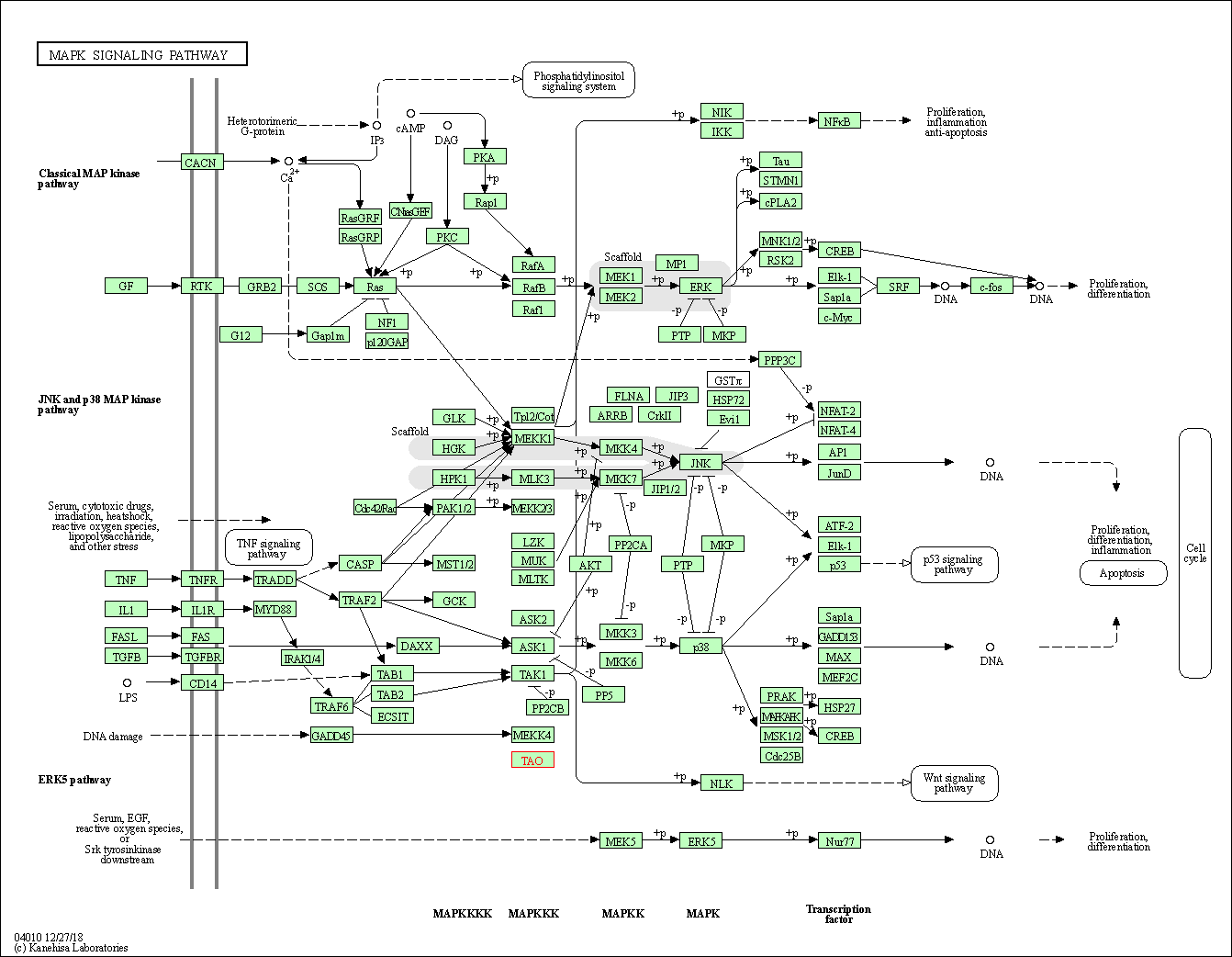Target Information
| Target General Information | Top | |||||
|---|---|---|---|---|---|---|
| Target ID |
T63682
(Former ID: TTDI03572)
|
|||||
| Target Name |
TAO kinase 3 (TAOK3)
|
|||||
| Synonyms |
hKFC-A; Thousand and one amino acid protein 3; Serine/threonine-protein kinase TAO3; MAP3K18; Kinase from chicken homolog A; KDS; Jun kinase-inhibitory kinase; JNK/SAPK-inhibitory kinase; JIK; Dendritic cell-derived protein kinase; DPK; Cutaneous T-cell lymphoma-associated antigen HD-CL-09; CTCL-associated antigen HD-CL-09
Click to Show/Hide
|
|||||
| Gene Name |
TAOK3
|
|||||
| Target Type |
Literature-reported target
|
[1] | ||||
| Function |
Serine/threonine-protein kinase that acts as a regulator of the p38/MAPK14 stress-activated MAPK cascade and of the MAPK8/JNK cascade. Acts as an activator of the p38/MAPK14 stress-activated MAPK cascade. In response to DNA damage, involved in the G2/M transition DNA damage checkpoint by activating the p38/MAPK14 stress-activated MAPK cascade, probably by mediating phosphorylation of upstream MAP2K3 and MAP2K6 kinases. Inhibits basal activity of MAPK8/JNK cascade and diminishes its activation in response epidermal growth factor (EGF).
Click to Show/Hide
|
|||||
| UniProt ID | ||||||
| EC Number |
EC 2.7.11.1
|
|||||
| Sequence |
MRKGVLKDPEIADLFYKDDPEELFIGLHEIGHGSFGAVYFATNAHTSEVVAIKKMSYSGK
QTHEKWQDILKEVKFLRQLKHPNTIEYKGCYLKEHTAWLVMEYCLGSASDLLEVHKKPLQ EVEIAAITHGALHGLAYLHSHALIHRDIKAGNILLTEPGQVKLADFGSASMASPANSFVG TPYWMAPEVILAMDEGQYDGKVDIWSLGITCIELAERKPPLFNMNAMSALYHIAQNDSPT LQSNEWTDSFRRFVDYCLQKIPQERPTSAELLRHDFVRRDRPLRVLIDLIQRTKDAVREL DNLQYRKMKKILFQETRNGPLNESQEDEEDSEHGTSLNREMDSLGSNHSIPSMSVSTGSQ SSSVNSMQEVMDESSSELVMMHDDESTINSSSSVVHKKDHVFIRDEAGHGDPRPEPRPTQ SVQSQALHYRNRERFATIKSASLVTRQIHEHEQENELREQMSGYKRMRRQHQKQLIALEN KLKAEMDEHRLKLQKEVETHANNSSIELEKLAKKQVAIIEKEAKVAAADEKKFQQQILAQ QKKDLTTFLESQKKQYKICKEKIKEEMNEDHSTPKKEKQERISKHKENLQHTQAEEEAHL LTQQRLYYDKNCRFFKRKIMIKRHEVEQQNIREELNKKRTQKEMEHAMLIRHDESTRELE YRQLHTLQKLRMDLIRLQHQTELENQLEYNKRRERELHRKHVMELRQQPKNLKAMEMQIK KQFQDTCKVQTKQYKALKNHQLEVTPKNEHKTILKTLKDEQTRKLAILAEQYEQSINEMM ASQALRLDEAQEAECQALRLQLQQEMELLNAYQSKIKMQTEAQHERELQKLEQRVSLRRA HLEQKIEEELAALQKERSERIKNLLERQEREIETFDMESLRMGFGNLVTLDFPKEDYR Click to Show/Hide
|
|||||
| 3D Structure | Click to Show 3D Structure of This Target | AlphaFold | ||||
| Cell-based Target Expression Variations | Top | |||||
|---|---|---|---|---|---|---|
| Cell-based Target Expression Variations | ||||||
| Drug Binding Sites of Target | Top | |||||
|---|---|---|---|---|---|---|
| Ligand Name: adenosine diphosphate | Ligand Info | |||||
| Structure Description | Crystal structure of human TAO3 kinase binding ADP | PDB:6BDN | ||||
| Method | X-ray diffraction | Resolution | 1.50 Å | Mutation | Yes | [2] |
| PDB Sequence |
DPEIADLFYK
17 DDPEELFIGL27 HEIGHGSFGA37 VYFATNAHTS47 EVVAIKKMSY57 SGKQTHEKWQ 67 DILKEVKFLR77 QLKHPNTIEY87 KGCYLKEHTA97 WLVMEYCLGS107 ASDLLEVHKK 117 PLQEVEIAAI127 THGALHGLAY137 LHSHALIHRD147 IKAGNILLTE157 PGQVKLADFG 167 SASMASPANS177 FVGTPYWMAP187 EVILAMDEGQ197 YDGKVDIWSL207 GITCIELAER 217 KPPLFNMNAM227 SALYHIAQND237 SPTLQSNEWT247 DSFRRFVDYC257 LQKIPQERPT 267 SAELLRHDFV277 RRDRPLRVLI287 DLIQRTKDAV297 RELDNLQYRK307 MKKILFQ |
|||||
|
|
ILE30
2.807
GLY31
2.579
HIS32
2.949
GLY33
2.574
SER34
3.771
PHE35
2.141
VAL38
2.824
ALA51
2.763
LYS53
2.028
GLU72
4.680
ILE85
2.568
MET101
2.761
GLU102
1.880
|
|||||
| Click to View More Binding Site Information of This Target with Different Ligands | ||||||
| Different Human System Profiles of Target | Top |
|---|---|
|
Human Similarity Proteins
of target is determined by comparing the sequence similarity of all human proteins with the target based on BLAST. The similarity proteins for a target are defined as the proteins with E-value < 0.005 and outside the protein families of the target.
A target that has fewer human similarity proteins outside its family is commonly regarded to possess a greater capacity to avoid undesired interactions and thus increase the possibility of finding successful drugs
(Brief Bioinform, 21: 649-662, 2020).
Human Tissue Distribution
of target is determined from a proteomics study that quantified more than 12,000 genes across 32 normal human tissues. Tissue Specificity (TS) score was used to define the enrichment of target across tissues.
The distribution of targets among different tissues or organs need to be taken into consideration when assessing the target druggability, as it is generally accepted that the wider the target distribution, the greater the concern over potential adverse effects
(Nat Rev Drug Discov, 20: 64-81, 2021).
Human Pathway Affiliation
of target is determined by the life-essential pathways provided on KEGG database. The target-affiliated pathways were defined based on the following two criteria (a) the pathways of the studied target should be life-essential for both healthy individuals and patients, and (b) the studied target should occupy an upstream position in the pathways and therefore had the ability to regulate biological function.
Targets involved in a fewer pathways have greater likelihood to be successfully developed, while those associated with more human pathways increase the chance of undesirable interferences with other human processes
(Pharmacol Rev, 58: 259-279, 2006).
Human Similarity Proteins
Human Tissue Distribution
Human Pathway Affiliation
|
|
|
Note:
If a protein has TS (tissue specficity) scores at least in one tissue >= 2.5, this protein is called tissue-enriched (including tissue-enriched-but-not-specific and tissue-specific). In the plots, the vertical lines are at thresholds 2.5 and 4.
|
| KEGG Pathway | Pathway ID | Affiliated Target | Pathway Map |
|---|---|---|---|
| MAPK signaling pathway | hsa04010 | Affiliated Target |

|
| Class: Environmental Information Processing => Signal transduction | Pathway Hierarchy | ||
| Chemical Structure based Activity Landscape of Target | Top |
|---|---|
| References | Top | |||||
|---|---|---|---|---|---|---|
| REF 1 | First Cdc7 kinase inhibitors: pyrrolopyridinones as potent and orally active antitumor agents. 2. Lead discovery. J Med Chem. 2009 Jan 22;52(2):293-307. | |||||
| REF 2 | Crystal structure of human TAO3 kinase binding ADP | |||||
If You Find Any Error in Data or Bug in Web Service, Please Kindly Report It to Dr. Zhou and Dr. Zhang.

